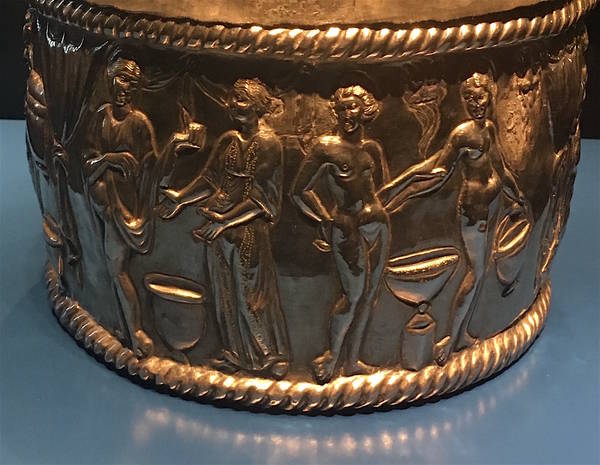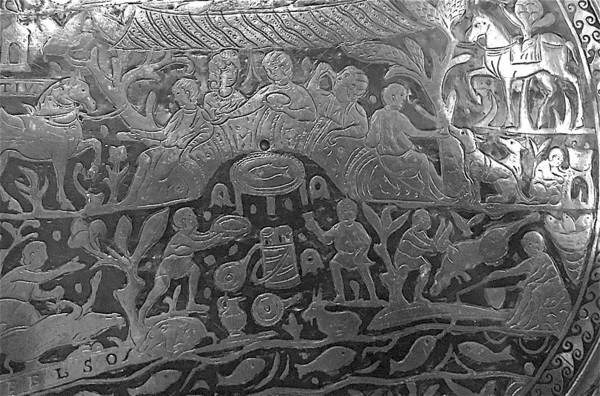
The magnificent Seuso Treasure has finally gone on public display, at the Hungarian National Museum in Budapest. We have waited a long time for this. The Treasure (14 stunning pieces of late imperial Roman silver) has had an unsteady and sordid career, passed from hand to hand like an expensive courtesan whose origins are obscure and best not investigated too closely. After many decades, Hungary–who always stoutly maintained her claim to the trove–has redeemed it from its demi-monde existence and placed it on show as a magnificent piece of Pannonian patrimony.
The 14 pieces are as follows: four huge platters, variously decorated; a washbasin; five large ewers; two elaborate situlae (water buckets); an embossed amphora and a conical-lidded casket for perfumed unguents. They were almost certainly not made as a single set (dating from the 4th–5th centuries, there is a range of about five decades between the oldest and the youngest pieces) and they include items worked in vastly different styles. The elegant, strigilated washbasin and two ewers with incised geometric designs, for example, which are assigned by some scholars to a “Western” workshop, are stylistically worlds away from the jug and amphora with Dionysiac scenes of frenzied maenads and inebriated satyrs, punched out in a sort of bubbling, varicose repoussé that seems opulently “Eastern”.
Though Hungary’s ownership is no longer contested, the exact findspot of the Treasure remains unclear. In the 1970s a young man called József Sümegh stumbled on a Roman hoard packed into a wide copper cauldron in the vicinity of the village of Polgárdi, east of Lake Balaton. Sümegh did not live long to enjoy his find. He died in mysterious circumstances at the age of just 24 and the treasure vanished. What is most likely is that this is it, although the trail of the pieces when they cropped up on the art market was for decades deliberately obfuscated by dealers, smugglers, heisters and crooks. The Getty Museum was at one stage interested in purchasing the silver, but pulled out because its provenance documents turned out to be forgeries. By the time it ended up in the hands of Lord Northampton in England, it numbered 14 pieces, perhaps vastly fewer than had originally been stashed away, hurriedly and in panic, by a Roman family clinging to the coat-tails of their civilisation as it fled from the barbarian invasions of Central Europe. After long and intricate negotiations, Hungary finally succeeded in repatriating the Treasure in two tranches, in 2014 and 2017. The money that they gave for it (tens of millions of euros) was paid not as a purchase price but as compensation for long years of care and custody of the silver by others. This summer it went on permanent public display.
Why the “Seuso” Treasure? It was customary for the owners of valuable Roman pieces to scratch their names on them. Seuso, however, is mentioned in a dedication incorporated into the design of the large Hunting Plate: a huge salver with a decorated rim and a central roundel filled with a busy scene. In the middle are figures dining under a canopy. Around them are scenes of hunting and fishing. Above a band showing water teeming with fish is the word “PELSO”, the Roman name for Lake Balaton. The whole design is of silver gilt with the details picked out in niello (a black-coloured alloy of sulphur with copper and lead). Circling the roundel is the following inscription: H[A]EC SEVSO TIBI DVRENT PER SAECULA MVLTA POSTERIS VT PROSINT VASCVLA DIGNA TVIS (“May these, O Seuso, yours for many ages be, small vessels fit to serve your offspring worthily”). Small vessels these are certainly not: the total weight of the pieces is a whopping 68.5kg. It has been suggested that some of the silver came from a set that was presented to Seuso as a wedding gift (one of the picnickers on the Hunting Plate is a woman sporting a hairstyle in the manner of Julia Domna, wife of Septimius Severus). Anything smaller that may have belonged to such a set, however—cups, spoons, toothpicks—has not come to light.

Stylistically and in terms of subject matter there are a number of parallels. The Hunting Plate shows similarities to the Cesena Plate in Italy (for an image, see here). The scenes of hunting, with animals being chased into nets, slaves butchering them, and a family seated on a stibadium (curved couch) under an awning slung between trees, feasting and feeding titbits to a dog while their horses are tethered in the background, is identical in many details to the 4th-century mosaic floor of the Sala della Piccola Caccia in the Villa del Casale in Sicily. One way in which it differs is in the absence of a scene of sacrifice to Diana, which might be significant. Between the first and the last words of the Seuso inscription, encircled in a laurel wreath, is a tiny Chi Rho. Seuso might have been a Christian. Nothing otherwise is known of him. From his name he would seem to have been a Celt and from the scenes depicted on his tableware, we can surmise that he was a landowner and keen hunter who lived a gracious life in one of the fine villas that existed in Pannonia. A veteran general, perhaps, grown wealthy from service to an empire into whose culture and lifestyle he was fully assimilated. The heterogeneous nature of the hoard suggests that he might have received rich gifts as rewards for his service.
More personal details are entirely lacking but it is tempting to speculate. The strapline of the Hungarian National Museum’s 2018 Seuso exhibit was “Wealth, Erudition, Power”. Certainly, Seuso must have been wealthy and with that wealth would have come a certain degree of power. But how erudite was he? How deep did his Romanisation go? Petronius, in his Satyricon (1st century AD), the famous send-up of a vulgar, nouveau riche banquet, puts the following words into the mouth of Trimalchio, the host:
“I absolutely love silver. I’ve got about a hundred wine cups showing how Cassandra killed her sons—the boys are depicted lying dead in the most lifelike way. Then there’s a bowl my patron left me with a scene of Daedalus shutting Niobe into the Trojan Horse. And there are some goblets with the fights between Hermeros and Petraites. All of good heavy make. I wouldn’t sell my connoisseurship at any price.”
Cultivated Roman readers would have snobbishly tittered at the malapropisms. Trimalchio has no connoisseurship; he is an uneducated ex-slave, a parvenu from some further corner of the Empire posing as a man well versed in the culture of the native elite. He muddles Cassandra with Medea, Niobe with Pasiphaë and the Trojan Horse with Daedalus’ wooden cow. Was Seuso’s grasp of Graeco-Roman myth as hazy as this? We have no idea. But what the Petronius extract does suggest is that it was normal for possessors of fine works of art to make a show of knowing what they had. The pictorial world of ancient Rome was extraordinarily uniform. From Britannia to the Balkans and beyond people would have seen the same scenes depicted in exactly the same way, in sculpture, pottery, metalwork, painting and mosaic. “I’ve got two exquisite silver-gilt pails with the story of Hippolytus and Phaedra,” Seuso might have boasted, “And a gorgeous platter showing Meleager having just dispatched the Calydonian Boar.” It is a signal of Rome’s remarkable achievement in co-opting and homogenising so many diffuse civilisations that all of Seuso’s dinner guests would have known what he was talking about—or at least felt it necessary to pretend they did. It is also an extraordinary privilege to be able to admire those objects now, tangible vestiges of provincial pomp, of days of laughter and conviviality in some long-gone lacustrine willow grove.
The Seuso Treasure, on display at the Hungarian National Museum. For more details and good-quality images, see their website (at present in Hungarian only). The Museum has also produced an excellent booklet about the Treasure, in English and several other languages.






